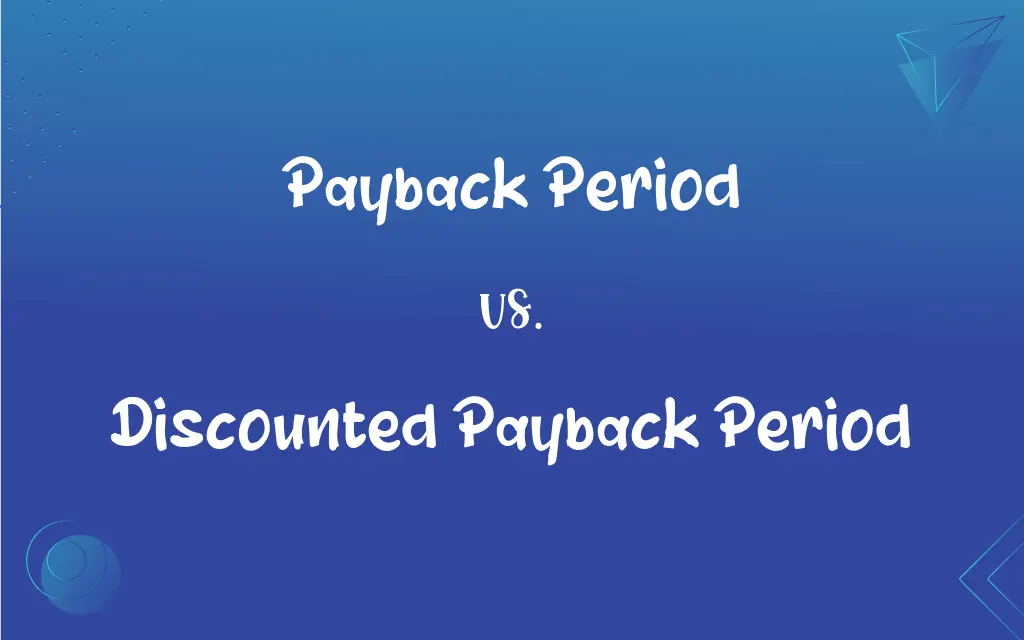Payback Period vs. Discounted Payback Period: What's the Difference?
Edited by Aimie Carlson || By Janet White || Published on January 7, 2024
Payback Period is time taken to recover the cost of an investment. Discounted Payback Period is time taken to recover the cost of an investment, considering the time value of money.

Key Differences
The payback period is a financial metric used to determine the time it takes for an investment to generate enough cash flows to recover the initial investment cost. The discounted payback period, meanwhile, adjusts these cash flows for the time value of money, reflecting the present value of future cash flows.
In calculating the payback period, all cash flows are considered equally, regardless of when they occur. In contrast, the discounted payback period discounts each cash flow to its present value, accounting for the cost of capital or a specific discount rate.
The payback period offers a simple and quick estimation of investment risk, focusing solely on the time needed to break even. The discounted payback period provides a more accurate and financially sound measure, as it includes the concept of the time value of money.
The payback period is easy to compute and understand, it ignores the value of money over time and cash flows after the payback period. The discounted payback period addresses these limitations by considering the diminishing value of future cash flows and providing a more comprehensive analysis.
The payback period can be misleading for long-term investments due to its neglect of the time value of money. The discounted payback period, however, gives a realistic view of the investment’s profitability by considering the reduced value of future cash flows.
ADVERTISEMENT
Comparison Chart
Time Value of Money
Ignores time value of money
Considers time value of money
Complexity
Simple to calculate
More complex due to discounting cash flows
Accuracy
Less accurate for long-term analysis
More accurate for long-term investments
Risk Assessment
Provides basic risk assessment
Offers a more thorough risk evaluation
Cash Flow Treatment
Treats all cash flows equally
Discounts future cash flows to present value
ADVERTISEMENT
Payback Period and Discounted Payback Period Definitions
Payback Period
The period in which an investment's cash inflows equal its outflows.
The company used the payback period to prioritize investments.
Discounted Payback Period
Time needed to break even on an investment, considering the discount rate.
A higher discount rate resulted in a longer discounted payback period.
Payback Period
A measure of how quickly an investment can break even.
They preferred projects with a short payback period.
Discounted Payback Period
The time it takes for the present value of cash inflows to equal the initial investment.
The discounted payback period was calculated considering a 5% discount rate.
Payback Period
Duration until an investment returns its original cost.
The payback period helped assess the investment's liquidity.
Discounted Payback Period
The period until the net present value of cash inflows equals the investment's cost.
The discounted payback period provided a more realistic investment timeline.
Payback Period
A calculation of the time it takes for an investment to pay for itself.
The longer payback period indicated higher risk.
Discounted Payback Period
Duration to recover investment cost, accounting for the time value of money.
The project's discounted payback period was longer than its simple payback period.
Payback Period
The time needed to recover the initial cost of an investment.
The project's payback period was three years.
Discounted Payback Period
A financial metric that discounts future cash flows to their present value.
They used the discounted payback period to evaluate the project's feasibility.
FAQs
Is the payback period suitable for long-term investments?
It's less suitable due to ignoring the time value of money.
Why is the discounted payback period considered more accurate?
It accounts for the time value of money, making it more realistic.
What does a short payback period indicate?
It suggests quick cost recovery and potentially lower risk.
Should companies rely solely on these metrics for investment decisions?
No, they should be used as part of a broader financial analysis.
What is the primary use of the payback period?
To estimate how quickly an investment recovers its costs.
Does the discounted payback period always result in a longer duration?
Generally, yes, as it discounts future cash flows.
How does discount rate affect the discounted payback period?
A higher discount rate usually extends the discounted payback period.
Are there limitations to using the discounted payback period?
It's more complex and still doesn't consider cash flows after the payback period.
Can payback period alone determine an investment's risk?
It provides a basic risk assessment but doesn't consider all factors.
Can the payback period evaluate profitability?
It mainly assesses the time to break even, not overall profitability.
Can these metrics be used for all types of investments?
They are widely applicable but have limitations depending on the investment type.
Does inflation affect the payback period calculations?
The standard payback period doesn't account for inflation.
Do these methods consider the quality of cash flows?
They focus on the timing and amount, not the quality of cash flows.
Does the payback period consider operational costs?
It typically focuses on the initial investment and gross returns.
How does risk tolerance affect the choice of these metrics?
Risk-averse investors might prefer the more conservative discounted payback period.
How does company policy influence the use of these metrics?
Company investment policies might dictate preference for one metric over another.
Is the discounted payback period influenced by interest rates?
Yes, interest rates can affect the discount rate used.
Can both metrics predict future cash flows?
They are based on estimates and don't predict but assess expected cash flows.
Can these metrics be applied to personal finance decisions?
Yes, they can be adapted for personal investment evaluations.
Are these metrics relevant in rapidly changing markets?
They can be less reliable in highly volatile or uncertain markets.
About Author
Written by
Janet WhiteJanet White has been an esteemed writer and blogger for Difference Wiki. Holding a Master's degree in Science and Medical Journalism from the prestigious Boston University, she has consistently demonstrated her expertise and passion for her field. When she's not immersed in her work, Janet relishes her time exercising, delving into a good book, and cherishing moments with friends and family.
Edited by
Aimie CarlsonAimie Carlson, holding a master's degree in English literature, is a fervent English language enthusiast. She lends her writing talents to Difference Wiki, a prominent website that specializes in comparisons, offering readers insightful analyses that both captivate and inform.






































































